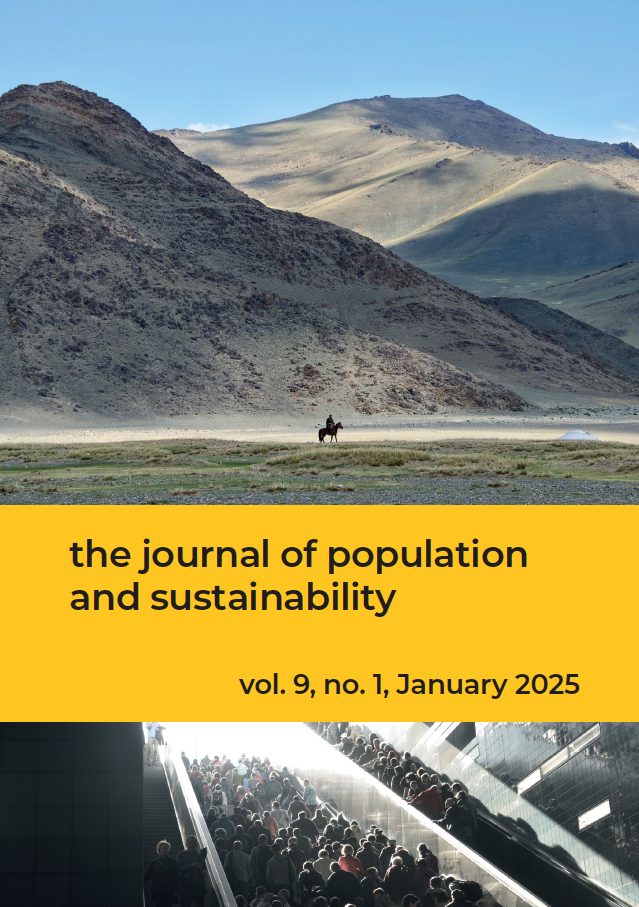Perspective
Published 2025-01-27
Keywords
- agriculture,
- carrying capacity,
- ecology,
- extinction,
- growth
How to Cite
Hopfenberg, Russell. 2025. “In Pursuit of Sustainability: The Root Cause of Human Population Growth”. The Journal of Population and Sustainability 9 (1):19-25. https://doi.org/10.3197/JPS.63799977346499.
Copyright (c) 2025 Russell Hopfenberg

This work is licensed under a Creative Commons Attribution 4.0 International License.
Abstract
Human population growth has been identified as the primary cause of ecologically destructive phenomena. The evidence clearly shows that global human population growth proceeds as a function of the increasing food supply. Understanding and appreciating this reality is posited as a first step in successfully addressing human population growth.
Downloads
Download data is not yet available.
References
- Allendorf, T.D., and K. Allendorf. 2012. ‘What every conservation biologist should know about human population’. Conservation Biology 26 (6): 953–55. https://doi.org/10.1111/j.1523-1739.2012.01919.x
- Bailey, R. 2004. ‘Make mine Malthus! Overpopulation panic’s eternal return’. Reason 28 July 2004: http://reason.com/archives/2004/07/28/make-mine-malthus (accessed 16 March 2024).
- Bradshaw C.J.A., P.R. Ehrlich, A. Beattie, et al. 2021. ‘Underestimating the challenges of avoiding a ghastly future’. Frontiers in Conservation Science 1: 615419, 1–10. https://doi.org/10.3389/fcosc.2020.615419
- Daily, G., P. Dasgupta, B. Bolin et al. 1998. ‘Global food supply-food production, population growth, and the environment’. Science 281 (5381): 1291–92. https://doi.org/10.1126/science.281.5381.1291
- Denissenko, M.F., A. Pao, M. Tang and G.P. Pfeifer. 1996. ‘Preferential formation of benzo[a]pyrene adducts at lung cancer mutational hot spots in P53’. Science 274(5286): 430–32. https://doi.org/10.1126/science.274.5286.430
- Gilland, B. 2002. ‘World population and food supply: Can food production keep pace with population growth in the next half-century?’ Food Policy 27: 47–63. https://doi.org/10.1016/S0306-9192(02)00002-7
- Global Food Security Act of 2016. Pub. L. 114-195, 20 July 2016, 130 Stat. 675. 22 USC §§9301 et seq.
- Hopfenberg, R. and D. Pimentel. 2001. ‘Human population numbers as a function of food supply’. Environment, Development & Sustainability 3 (1): 1–15. https://doi.org/10.1023/A:1011463231976
- Hopfenberg. R. 2003. ‘Human carrying capacity is determined by food availability’. Population and Environment 25 (2): 109–17. https://doi.org/10.1023/B:POEN.0000015560.69479.c1
- Hopfenberg, R. 2014. ‘An expansion of the demographic transition model: The dynamic link between agricultural productivity and population’. Biodiversity 15 (4): 246–54. https://doi.org/10.1080/14888386.2014.973904
- Hopfenberg, R. 2019. ‘Population density and redistribution of food resources’. In P. Ferranti, P., E.M. Berry and J.R. Anderson (eds). Encyclopedia of Food Security and Sustainability, vol. 1, pp. 26–30. Amsterdam: Elsevier. https://doi.org/10.1016/B978-0-08-100596-5.22379-2
- Marshall, C. 2016. ‘Nature loss linked to farming intensity’. BBC News, 14 September: http://www.bbc.com/news/science-environment-37298485. (accessed 23 October 2023)
- McKee, J.K. 2004. ‘Brother, can you spare a species?’ The Reporter (Spring): 6–9.
- Meffe, G.K., A.H. Ehrlich and D. Ehrenfeld. 1993. ‘Human population control: the missing agenda’. Conservation Biology 7: 1–3. https://doi.org/10.1046/j.1523-1739.1993.07010001.x
- Mora, C. 2014. ‘Revisiting the environmental and socioeconomic effects of population growth: a fundamental but fading issue in modern scientific, public, and political circles’. Ecology and Society 19 (1): 38. https://doi.org/10.5751/ES-06320-190138
- Pearce, F. 1984. ‘The threat of overpopulation wanes’. New Scientist 103 (1417): 8.
- Pimentel, D. 1966. ‘Complexity of ecological systems and problems in their study and management’. In K. Watt (ed). Systems Analysis in Ecology, pp. 15–35. New York: Academic Press. https://doi.org/10.1016/B978-1-4832-3283-6.50008-X
- Quinn, D. 2010. ‘The danger of human exceptionalism’. In K.D. Moore and N.P. Nelson (eds). Moral Ground: Ethical Action for a Planet in Peril, pp. 9–14. San Antonio: Trinity University Press.
- Rodrigo, M. and D. Zulkarnaen. 2022. ‘Mathematical models for population growth with variable carrying capacity: Analytical solutions’. AppliedMath 2 (3): 466–79. https://doi.org/10.3390/appliedmath2030027
- Rosset, P., J. Collins and F.M. Lappé. 2000. ‘Lessons from the Green Revolution’. Tikkun 15 (2): 52.
- Sasco, A.J., M.B. Secretan and K. Straif. 2004. ‘Tobacco smoking and cancer: a brief review of recent epidemiological evidence’. Lung Cancer 45: S3–S9. https://doi.org/10.1016/j.lungcan.2004.07.998
- Scott, E.C. 1997. ‘Antievolution and creationism in the United States’. Annual Review of Anthropology 26 (1): 263–89. https://doi.org/10.1146/annurev.anthro.26.1.263
- Skinner, B.F. 1990. ‘Can psychology be a science of mind?’ American Psychologist 45 (11): 1206–10. https://doi.org/10.1037//0003-066X.45.11.1206
- Stebbing, T. 2011. A Cybernetic View of Biological Growth: The Maia Hypothesis. Cambridge: Cambridge University Press. https://doi.org/10.1017/CBO9780511933813
- Strecker, R.L. and J.T. Emlen. 1953. ‘Regulatory mechanisms in house-mouse populations: the effect of limited food supply on a confined population’. Ecology 34: 375–85. https://doi.org/10.2307/1930903
- Vitousek, P.M., H.A. Mooney, J. Lubchenco and J.M. Melillo. 1997. ‘Human domination of Earth’s ecosystems’. Science 227 (5325): 494–99. https://doi.org/10.1126/science.277.5325.494
- Weiss, K.R. 2016. ‘“Convince them to say it”’. In R. Engelman et al. (eds). Family Planning and Environmental Sustainability: Assessing the Science, pp. 39–41. Washington, DC: Worldwatch Institute, 2016.





